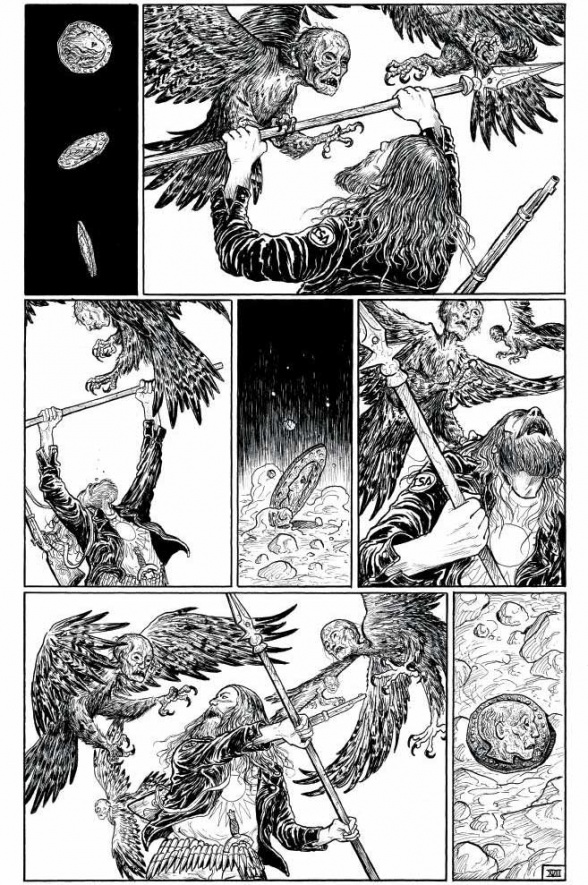Written and illustrated by Zé BurnayAndromeda, or The Long Way Home is a graphic novel by Zé Burnay, a freelance illustrator and comic book creator from Sintra, Portugal. Since 2016 he’s been self-publishing a series of comics called Andromeda, which will be collected into a beautiful hardcover book, along with new material and an ambient music soundtrack.
I’ve had the pleasure of reading the first two “Andromeda” stories, ‘Bugonia’ and ‘A House on the Horizon,’ as well as a preview of an unlettered work-in-progress version of ‘Our Mother, the Mountain.’ These three stories will be featured in Zé Burnay’s upcoming book, “Andromeda, or The Long Way Home,” which was recently successfully funded on Indiegogo. The campaign is still running, so check it out and lend your support if you can.
It’s hard not to get swept up in Zé Burnay’s work. The first story, ‘Bugonia,’ is wordless, yet utterly captivating. The detail of his work invites readers to linger on each page and ponder the details—there are two suns in the sky, so I guess this isn’t Earth. He’s wearing bandoliers full of bullets, but he doesn’t appear to have a gun… I guess this mysterious wanderer has already been through some stuff. The questions are simple at first, but as the comic progresses, the questions become bigger and the comic takes on a more dreamlike quality, at times even nightmarish.
Though ‘Bugonia’ is only twelve pages long, by its end there’s already a sense of an expansive history behind it all. It is a fragmentary glimpse of a larger world, but what a tantalizing fragment it is.
‘A House on the Horizon’ is a much bigger story, opening up Burnay’s world further, pushing the dreamlike imagery into stranger territory. The story also introduces dialogue, which only serves to amplify the strangeness of the world the nameless wanderer finds himself in. Burnay populates his world with predators—vultures, wolves, lions—all with human heads. We’re familiar with creatures like these, from the sphinx to the harpy, and the Burnay’s work draws on this association to give a mythic yet unsettling quality to his tale.


Even though his wanderer is dressed in fairly modern clothes, Burnay’s comic “Andromeda” feels like something from an old world. You get a sense that each creature he encounters has its own fable or myth associated with it. Obviously, with a name like “Andromeda,” the connection to mythology, especially Greek mythology, is no accident (though there hasn’t yet been an explicit reference to the titular Ethiopian princess in the first two stories).
There are references to other figures of Greek myth though, with a prominent depiction of Omphale appearing in ‘A House on the Horizon.’ Her connection to the events of the story are not made explicit, but rather left to the reader’s imagination. Burnay gives the reader just enough information to form their own theories, but not enough to ever be certain. This works to his advantage—the world of “Andromeda” is not a world of certainty.
While ‘A House on the Horizon’ employs dialogue, it’s still a story driven by imagery. Burnay rewards readers that linger on each panel, soaking up every detail. There’s nothing in the dialogue to connect the conflict of ‘Bugonia’ to the conflict in ‘A House on the Horizon,’ but for those looking for it, it is unambiguously there in the visuals.
The final tale, ‘Our Mother, the Mountain,’ impresses even in its incomplete state. I found the pages of Burnay’s raw pencils especially engrossing with its little notes scrawled in the gutters (like “space bees”) and I do hope some of these make it into the final book’s special features material.
‘Our Mother, the Mountain’ moves the tale from bare plains and rock to pine forestry. The care that Burnay’s taken to bring this environment to life is palpable. I love that it isn’t a clean forest. The ground is littered with fallen boughs tangled with bones and covered in sheets of moss. It looks both beautiful and treacherous. Again, Burnay explores some dreamlike imagery, which I won’t spoil here, but once again he pushed it further than in his previous stories. It certainly seems as though “Andromeda” will continue to become stranger as the story progresses, which makes it all the more enticing.
“Andromeda, or The Long Way Home” is an impressive body of work, even in its unfinished state. From what I’ve seen, my hope is that this is just the beginning, the first book in a series. Burnay clearly has a vast world in his head, and I’m eager to explore it as he puts it to the page.
“Andromeda, or The Long Way Home” is fully funded, and with only fifteen pages left to ink, Burnay expects he’ll be finished before the end of 2018 with the book going to printers in January. The book also comes with an ambient music soundtrack and a special features section including pin-ups from Mike Mignola (“Hellboy”), Artyom Trakhanov (“Slavic Nihilism”), Frans Boukas (“Bartkira”), John Kenn Mortensen (“Sticky Monsters”), Matt Smith (“Barbarian Lord”), Simon Roy (“Prophet”) , Aaron Conley (“Sabertooth Swordsman”) and others. Check it out. This is a truly impressive-looking project.




